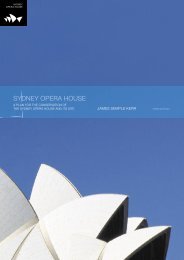Stage 3 - Sydney Opera House
Stage 3 - Sydney Opera House
Stage 3 - Sydney Opera House
- No tags were found...
Create successful ePaper yourself
Turn your PDF publications into a flip-book with our unique Google optimized e-Paper software.
Lesson Content and Teaching/Learning Activities Resources Register3(cont.)bODY PART EMOTIONS• Ask students to find a space in the room to work through the followingactivities. Students are to show the given emotion using the body partselected.• Face - sadness• Hands - happiness• Knees - scared• Elbows – Nervous• Hands – anger• Face – surprised• Students are to work in pairs and show opposite emotions e.g. Face – happy/sad, Hands angry/scared. Ask pairs to come up with their own combinations.Guidelinesfor classroomdramaStill ImagePrompt list4 PREPARATION fOR INTERACTION WITH DISCOVER THE STAGE DIGITAL WORkSHOP(Omit if class has already done Discover the <strong>House</strong>)• Before the day of the excursion have a discussion with your class aboutinteracting with digital workshop. Topics you might like to cover include:• What is a digital workshop? It is the ability to experience something first handwithout leaving the comfort of your classroom. Digital excursions also giveyou the ability to go places that you couldn’t normally, e.g. behind the scenesor under the sea.• Being aware that the workshop presenters can hear and see everyone at alltimes, just like with any excursion and they are happy to answer questionsthroughout the experience.• Appropriate behaviour towards the workshop presenter and the other schoolsthat will be present on the digital workshop. Turn taking, speaking loudly andclearly etc.• Have fun and don’t be shy!5 PLAY bUILDING CHARACTER AND ROLE PLAYCHARACTER DEVELOPMENT• Students are to work in small groups (3-4 students). Each group is to be givena stimulus image (examples provided). Students should work through thefollowing tasks to support the building of characters based on the given image.• Discuss the image: where is it, when is it, who is involved?• Decide on the characters involved in the image: give them a name, an age,three key things about their personality• Decide on the relationship between the chosen charactersHOT SEATINGNB. Hot Seating is an activity to assist the building and exploration of character and canbe used in the development of characters as well as learning about existing characters fromnovels or times in history e.g. Captain Cook or Harry Potter• A volunteer should be selected to take the ‘hot seat’. Students to ask themquestions about their character. These could include basic information (name,age) as well as more complex questions about likes, dislikes, relationships etcThis activity should be repeated for a number of volunteersROLE PLAY• Students should re-form into their original groups and discuss any new oraltered information that may have emerged in the hotseat activity.• Students to work on a short role play which demonstrates how each of thecharacters interact and how they are related to the stimulus image. Studentsshould be given at least 10 minutes to complete this section of the lesson.• Volunteer groups to perform their role plays.StimulusImages6house:Ed 2012
















